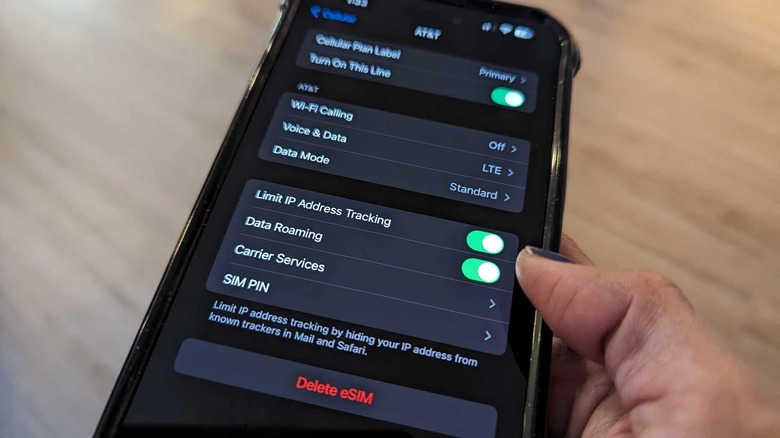What Is Data Roaming On iPhone (And Should You Turn It Off)?
In general, there are two ways you can get connected to a person via a mobile phone. If you are somewhere with internet connectivity available, you can make phone calls through Wi-Fi, among other things. The price to pay for such a connection may vary and will depend on where you are and what internet service you are using, but in most cases, especially if you are in a public establishment that offers Wi-Fi to its customers, you may be able to get it for free.
On the other hand, if you are out and about, are nowhere near a place that has a Wi-Fi router, and don't have a portable internet device handy, the only other way you can get connected on your smartphone is through cellular data, which you can acquire through a mobile phone plan or by tethering off of a mobile device that has it. These plans usually offer services like unlimited talk and text, and will sometimes include international perks that let you extend your ability to make calls, send messages, and use apps while overseas. Unlike using your phone while it's connected to Wi-Fi, you will likely incur charges when you use your device in certain ways by using your allotted mobile data.
On an iPhone, the quickest way to check if you have mobile connectivity is by launching the Settings app and choosing Cellular from the menu. There, you may also see other connection options, such as Personal Hotspot — which lets you share an internet connection via Bluetooth — and Data Roaming, an important cellular feature worth getting into if you've never encountered it before.
The iPhone's data roaming feature, defined
Like the name implies, it's a special online connectivity setting that lets you "roam" and use your mobile phone plan's gigabyte allotment for internet use. However, unlike regular cellular data, data roaming specifically refers to the ability of your iPhone to connect to the internet over a cellular data network not covered by your phone service provider. Simply put, it pertains to using wireless connectivity while you're in a foreign country that's not included in your phone carrier's coverage areas.
Apart from the basic service offerings, most unlimited U.S. phone plans offered by major carriers like AT&T, T-Mobile, and Verizon also offer unlimited talk, text, and data in Canada and Mexico. If you're planning to head elsewhere abroad, you may need to get in touch with your phone carrier to find out what your international plan add-on options are. Depending on your iPhone model, carrier, and region you're traveling to, you may have certain cellular data options available to you, so it's important to reach out to customer support so you can get advice on how to configure your mobile device's data roaming-related settings.
Where to find data roaming settings on your iPhone
Based on testing and various tech guides online that offer mixed answers, there's no definite way of knowing whether data roaming is enabled on your iPhone by default. It may depend on the country you are based in, how and where you acquired your device, or the phone service provider you are subscribed to. If you don't remember enabling or disabling the setting, this is how you can check:
- Launch the Settings app.
- Tap Cellular or Cellular Data.
- Ensure that the toggle next to Cellular Data is in the on position.
- If your device has a single SIM card or eSIM, tap Cellular Data Options. If your iPhone uses Dual SIM or Dual eSIM, select the number you want to check.
At this point, the Data Roaming switch should be visible onscreen. If you don't see it and your iPhone uses Dual SIM or Dual eSim, you might need to tap Cellular Data Options to find it. If the toggle is in the on position (green), that means data roaming is enabled on your device.
When to enable or disable data roaming on your iPhone
Leaving the feature enabled while you're in the country where you bought your iPhone and registered your mobile phone plan shouldn't have any bearing on your ability to acquire a cellular signal in areas serviced by your phone carrier. It's something that you need to keep an eye on when you're headed to an international destination with your iPhone, to countries or regions not covered by your existing phone plan. In any case, leaving the feature switched off until you actually need it is good practice.
International phone charges are notoriously pricey, especially if you have a premium plan in place for domestic use. If you use your iPhone abroad as you would normally — using apps and streaming content without much concern because you have unlimited data back home — and don't have an international plan or add-on in place, you may come back to a bloated bill filled with unexpected fees and higher rates. To avoid this, ask your phone carrier about international coverage. You can also disable data roaming on your iPhone by following the instructions outlined earlier and switching the Data Roaming toggle off.
Most international data plans will require you to have your iPhone's Data Roaming setting switched on, however. If you need help remembering when your iPhone's data roaming feature is active while you are in a foreign country, the cellular data network icon should be visible in the status bar of your device. When it's off, you should either see "SOS" or "No service" on your iPhone instead.



